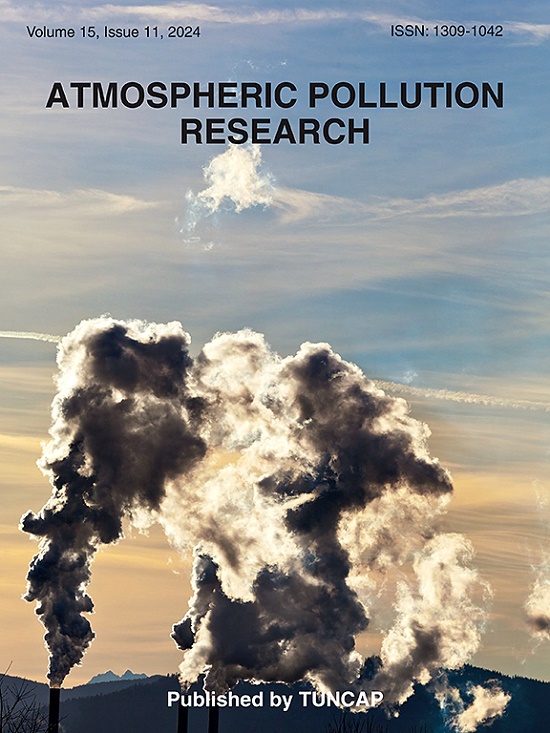2004-2018年中国大陆环境PM2.5组分对肺结核发病率长期影响的时间变化
IF 3.5
3区 环境科学与生态学
Q2 ENVIRONMENTAL SCIENCES
引用次数: 0
摘要
环境细颗粒物(PM2.5)与肺结核(PTB)广泛相关。然而,PM2.5特定组分对PTB的影响和时间变化知之甚少。在这项研究中,我们采用断点回归和分布滞后非线性模型(DLNM)来评估长期暴露于PM2.5及其成分(包括硫酸盐(SO42−)、硝酸盐(NO3−)、铵(NH4+)、有机质(OM)和黑碳(BC))对2004 - 2018年中国大陆31个省份14816329例肺结核病例的影响的时间变化。我们还通过元回归探讨了异质性的来源。研究发现,长期暴露于PM2.5成分与每月更高的肺结核发病率有关。NH4+的累积相对危险度(CRR和95% CI)最高,为每四分位范围(IQR)增加1.379 (95% CI: 1.331 ~ 1.428),其次是NO3−1.361 (95% CI: 1.314 ~ 1.409), SO42−1.331 (95% CI: 1.282 ~ 1.382), OM 1.130 (95% CI: 1.091 ~ 1.171), BC 1.126 (95% CI: 1.084 ~ 1.170)。涂片阳性肺结核(SPPTB)表现出更高的易感性。这种关联在不同的社会经济和医疗水平之间差异显著。在人均可支配收入、城市化率和每千人医疗技术人员数量较低的地区,NO3−和NH4+与PTB发病率较高相关。随着时间的推移,PM2.5组分单位增加的效应量显著减小,但NH4+、NO3−和SO42−对PTB的影响仍然很大。这一观察结果可能是由于PM2.5暴露水平的降低和社会经济地位因素的变化,如经济和医疗体系的进步。本研究揭示了不同PM2.5组分对肺结核发病率影响的时间变化规律,确定了诱发肺结核的关键有害组分,为针对特定PM2.5源制定肺结核防治策略提供了科学依据。本文章由计算机程序翻译,如有差异,请以英文原文为准。
Temporal variations in the long–term effects of ambient PM2.5 components on pulmonary tuberculosis incidence in mainland China during 2004–2018
Ambient fine particulate matter (PM2.5) has been widely associated with pulmonary tuberculosis (PTB). However, less is known about the impact and temporal variations of specific PM2.5 components on PTB. In this study, we employed breakpoint regression and distributed lag nonlinear models (DLNM) to assess the temporal variations in the effects of long−term exposure to PM2.5 and its components, including sulfate (SO42−), nitrate (NO3−), ammonium (NH4+), organic matter (OM), and black carbon (BC) on the incidence of 14,816,329 PTB cases across 31 provinces in mainland China from 2004 to 2018. We also explored sources of heterogeneity through meta-regression. The study found that long−term exposures to PM2.5 components were linked to higher monthly PTB incidence. The cumulative relative risks (CRR and 95 % CI) were highest at 1.379 (95 % CI: 1.331−1.428) per interquartile range (IQR) increase in NH4+, followed by 1.361 (95 % CI: 1.314−1.409) for NO3−, 1.331 (95 % CI: 1.282−1.382) for SO42−, 1.130 (95 % CI: 1.091−1.171) for OM, and 1.126 (95 % CI: 1.084−1.170) for BC. Smear−positive pulmonary tuberculosis (SPPTB) showed greater susceptibility. This association varied significantly across different socioeconomic and healthcare levels. In regions with lower per capita disposable income, urbanization rate, and the number of medical technical personnel per 1000 persons, NO3− and NH4+ were associated with higher PTB incidence rates. Over time, the effect sizes per unit increase in PM2.5 components has significantly diminished, but the impact of NH4+, NO3− and SO42− on PTB remains substantial. This observation might be due to reductions in PM2.5 exposure levels and changes in socioeconomic status factors, such as advancements in the economy and healthcare systems. Our study highlights the temporal variations in the effects of different PM2.5 components on PTB incidence, identifies key harmful components contributing to PTB, and provides scientific evidence for the PTB prevention and control strategies targeting specific PM2.5 sources.
求助全文
通过发布文献求助,成功后即可免费获取论文全文。
去求助
来源期刊

Atmospheric Pollution Research
ENVIRONMENTAL SCIENCES-
CiteScore
8.30
自引率
6.70%
发文量
256
审稿时长
36 days
期刊介绍:
Atmospheric Pollution Research (APR) is an international journal designed for the publication of articles on air pollution. Papers should present novel experimental results, theory and modeling of air pollution on local, regional, or global scales. Areas covered are research on inorganic, organic, and persistent organic air pollutants, air quality monitoring, air quality management, atmospheric dispersion and transport, air-surface (soil, water, and vegetation) exchange of pollutants, dry and wet deposition, indoor air quality, exposure assessment, health effects, satellite measurements, natural emissions, atmospheric chemistry, greenhouse gases, and effects on climate change.
 求助内容:
求助内容: 应助结果提醒方式:
应助结果提醒方式:


